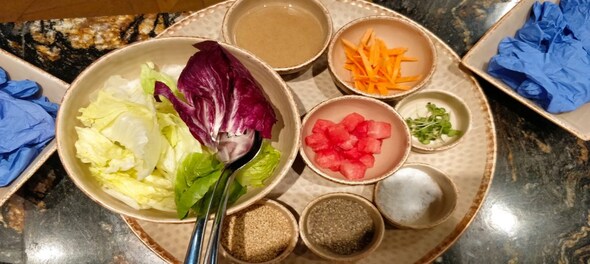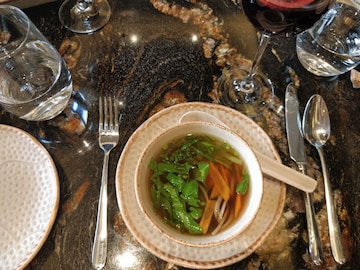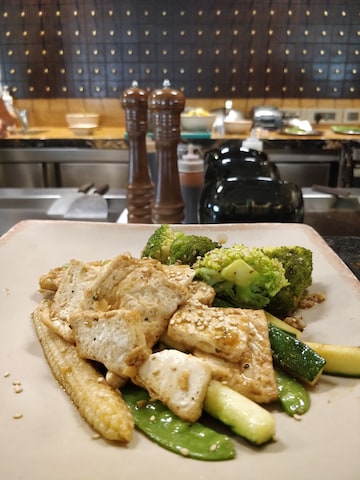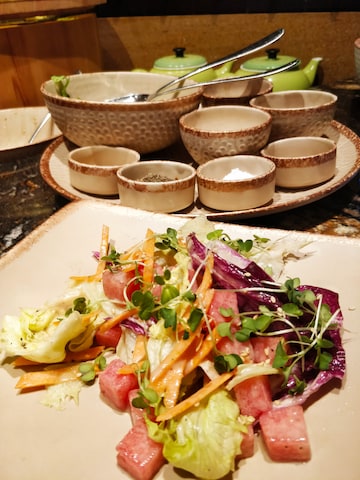
The monsoon season requires a different sort of diet, one that feels fresh and flavoursome, yet light on the tummy and not laden with oils and fats. Instead of rich curries and fried foods, one needs a slightly curated menu this season.
Keeping the sultry climes of the Indian weather in mind at this time of the year, the chefs at Oko, the oriental-food speciality restaurant at The LaLiT Delhi, suggest a delectable meal that would fill you up while keeping your energy levels high and your taste buds invigorated.
One of the first things advised at this time of the year is to go easy on the heavy red meats, and instead opt for lighter meats such as fish and chicken. The other is to ditch the rich gravies for clear soups and stews.
Spicy food is also not advised; it’s better to stick to recipes that are lightly flavoured with beneficial herbs. Food preparation also needs a bit of a twist; instead of frying, go for sautéing or steaming instead.
Here is a list of nutritious ingredients and cooking techniques that will hit the sweet spot this monsoon.
Go for Soba Noodles
 Soba noodle and hot Dashi soup
Soba noodle and hot Dashi soupMade with buckwheat, soba noodles are an excellent addition to your soup bowl this season. Eating buckwheat has been shown to lower blood sugar, improve heart health and even prevent cancer.
Try a soup made with soba noodles. Boil the noodles, drain them and rinse them with hand under cold water. Using a slotted spoon, stir a bowl of julienned bokchoy, soy sauce, sliced asparagus and carrots, and chopped spring onion. Meanwhile, make hot Dashi stock using diced carrots, onions, leek, celery, coriander stems, along with crushed ginger and garlic boiled in water.
Transfer the hot Dashi stock to your bowl of vegetables, and simmer at least 15 minutes to enhance the flavour. Add salt and crushed black pepper. When you’re ready to serve, pour the hot soup over the boiled and drained soba noodles, and add toppings as required.
Saute Not Fry
 Sauteed vegetables and tofu
Sauteed vegetables and tofuSautéing is fast and favoured method of cooking vegetables, especially during the monsoon season. All the ingredients are to be placed on the pan at around the same time, cooked quickly on high heat, and then removed and served immediately. It uses less oil or fat than frying, and helps the body absorb fat-soluble vitamins faster.
But there are tips to keep in mind to optimise the nutrient intake of your sautéed vegetables. Soak the whole vegetables in tepid, salty water for 20 minutes to remove all traces of pesticides or wax used for supermarket display. While chopping, avoid removing vegetable peels if they are edible, as this is where most nutrients are to be found. Ideally, you should cut your vegetables into larger pieces – the smaller they are cut, the more nutrients are lost to air.
Similarly, start sautéing your vegetables as soon as possible after chopping, so they don’t lose too many vitamins from exposure. Cook for the shortest time necessary at a moderately high temperature, but make sure to keep turning over the vegetables constantly to avoid burning.
Harness the Strength of Sesame
 Fresh salad topped with sesame dressing
Fresh salad topped with sesame dressingSesame seeds are a potent dose of nutrition, especially for vegetarians. The rich omega fatty acids present in white sesame seeds promote hair growth, improve blood circulation, and boost skin health. The antioxidants in the seeds reverse signs of ageing, and the high fibre content boosts digestion.
They are also an excellent and healthy way to boost energy levels as they contain healthy fats like polyunsaturated fatty acids and Omega-6. Besides fibre, they also have iron, calcium, magnesium and phosphorus, and help stabilise blood pressure.
Chef Shekhar at Oko has come up with a delicious sesame dressing for salads that really delights your taste-buds. Whisk together 50 gm of white sesame seeds, 20 ml Kikkoman soya, 5 gm sugar, 20 ml olive oil, 5 ml lemon juice, a pinch of salt and 2 drops of white wine vinegar. Store this in your refrigerator until your salad is ready for dressing.
Steam Fish Inside Banana Leaves
South Asian cuisines are famous for steaming food using banana leaves. Not only does this give the food a sweet taste and a soft fragrant flavour, the leaves also make a protective sheet to keep thͦe juices and nutrition of the food intact, and protect the food from burning or catching fire while cooking.
Banana-wrapped and steamed sea bass is an excellent dish this time of the year. Make a smooth marinade using chopped ginger, garlic, Kaffir lime leaves and red chilli, along with 100 ml oyster sauce and half tablespoon of Thai fish sauce in a bowl.
Marinate a steak of sea bass fish with the paste. Then, wrap the marinated fish with a banana leaf and keep it resting for at least two hours in the refrigerator.
Preheat your grill to 280˚C, and place the wrapped fish steak on the grill. Cover with a lid and keep drizzling water under it. Cook for at least 10 minutes.
First Published: Aug 31, 2019 5:59 PM IST
Check out our in-depth Market Coverage, Business News & get real-time Stock Market Updates on CNBC-TV18. Also, Watch our channels CNBC-TV18, CNBC Awaaz and CNBC Bajar Live on-the-go!


Supreme Court says it may consider interim bail for Arvind Kejriwal due to ongoing Lok Sabha polls
May 3, 2024 4:57 PM
10% discount on fare on Mumbai Metro lines 2 and 7A on May 20
May 3, 2024 2:40 PM

